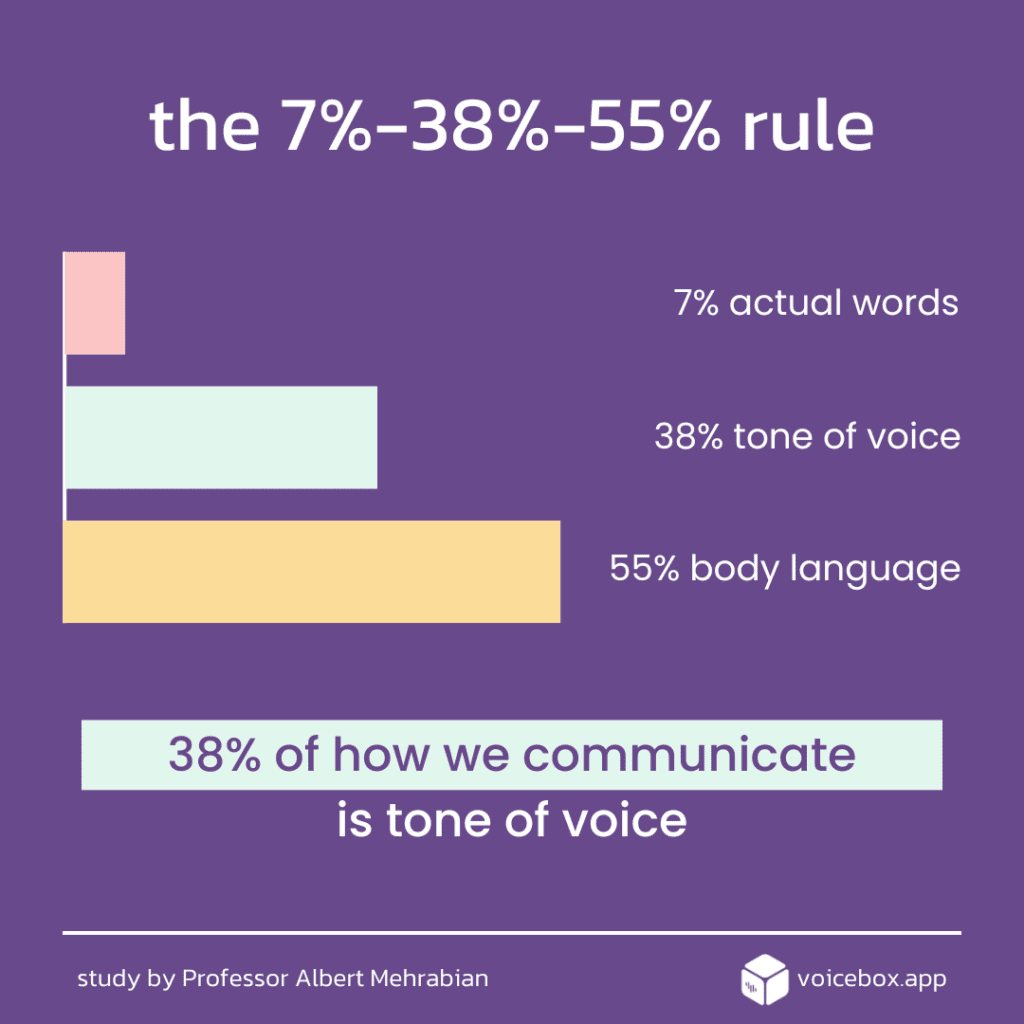Listen to the blog post here.
I heard this joke once on a podcast by Mikaeel Smith where he claimed that you can say the same phrase, but, depending on the way you say it, convey completely different meanings. He proceeded to repeat the phrase “you good” in various tones from “you good” to “you good” to “you good”...this joke doesn’t work nearly as well if you read it, but that’s my meta way of proving the point. Voice is powerful indeed. Just by saying “you good” in different ways, Mr. Smith was able to express concern, approval, and suspicion with the same two words.
It’s Not What You Said, It’s How You Said It
Since just about every phenomenon has a term, I decided to look this one up and quickly found that sure enough, there’s a term for this too! Coined by Dr. Albert Mehrabian, the 7%-38%-55% rule states that when a speaker tries to express their emotions, only 7% of their meaning is communicated through their actual words. The majority (55%) is through body language, and the remaining 38% is by tone of voice. So the cliché is true. It’s not always about what you say, but often how you say it.
In a digital world where text flies around like pages blowing in a hurricane, the loss of 93% of communication has some unfortunate implications. At the heart of the matter, stripping our voices from our words makes communication less effective and accurate. Imagine trying to tell someone about how difficult it has been for you to deal with losing your job. Imagine trying to convey the joy you feel at the birth of your first child. Imagine trying to persuade people to join you at a protest.
While posts like these may go viral in terms of shares and likes, these metrics inadequately measure the impact of the message on the recipient. We can't even say for sure if the message got across as intended. In a text-only medium, our calls to action are less urgent, our good news are less celebratory, and our struggles are diminished because words without emotions are like foods without spices. The same set of foods can taste completely different depending on how you prepare the meal.
Emotion, however, is a two-way street. Our inability to convey nuance through text alone is one edge of the sword, with the other being the inability to understand nuance. Every now and then we’ll get a kick out of some schmuck in a comments section who confuses another’s sarcasm for real thoughts, but this is a humorous drop in a bucket otherwise filled with concern.
As Dr. Helen Riess points out in her book The Empathy Effect, our constant exposure to the digital has diminished one of the most human skills of all: empathy. Empathy is the ability to share and understand the feelings of another. While the pitfalls of a lack of empathy in a digital world, such as cyberbullying, are tragic enough, it remains to be seen how this will spill into our real lives where there is more to interacting with someone than likes and emojis.

More Than a Meaning, It's a Feeling
The power of voice (POV) goes beyond just conveying emotion and information. What we hear has a significant effect on our psyche, even before we are born. Dr. Jennifer Shu recommends reading, singing, and speaking to your unborn baby because those same sounds can comfort them when they are born. Of course, unless you’re some otherworldly genius fetus, chances are you don’t remember the things you heard in the womb.
A more relevant example of POV is the effect music has on us. Music excels at speaking to people’s emotions. It’s the reason why you can find comfort in listening to a song about heartbreak when you’re going through a breakup yourself or why you can’t help but tap your foot to a catchy beat. It’s the reason why you can socialize or even strike family-like bonds with people who share the same interest in music. Think BTS Army or the Beyhive.
It’s also the reason why you may be able to recite the lyrics to a song you haven’t heard since you were a child. Brain studies show that music sparks neural activity, which can lead to a strong connection with it. This imprinting effect isn’t accomplished by the meaning and relatability of the words alone. Other audial factors such as rhythm, rhyme, and alliteration compound the memorability of these lyrical works.
Speeches and quotes further demonstrate how POV invokes some effect within the listener. Dr. Martin Luther King Jr.’s “I Have a Dream” speech would hardly have had the same inspirational effect had people read it instead of hearing it. If JFK texted us, "Ask not what your country can do for you...", we wouldn't make it to the end of the text.
To this day, Presidents deliver inauguration speeches and State of the Union addresses with their voices, even though they could easily share a transcript online. Why is that? Because we can't replicate the impact of spoken words by reading them. Much like a song you know from childhood, famous quotes too can find a home in your mind that you can recall at will for inspiration, comfort, or just for kicks. If I said, “May the voice be with you”, you might respond, "You're a jedi, Harry."
A More Human Way to Connect
So great, vocal art, speeches, and even the occasional movie quote all hit harder when heard, but what about POV in our everyday conversations? Consider the difference between hearing your significant other tell you “I love you” versus them texting it to you. This is a simple yet powerful example of how voice establishes a more meaningful connection between people. Whether that be positive emotions like affection and sympathy or negative ones like anger or sadness, voice better enables us to relate to one another. It establishes stronger relationships.
The desire for more human interaction manifests itself in technology all the time. Technologies in their early days were very robotic and very obviously not human. However, the strides we have made in humanizing technology have made it far more lifelike and engaging.
A constantly evolving example of this is graphics. When YouTube started in 2005, it supported video resolutions of up to 320x240. When Blu-ray came out in 2006, I remember remarking to my brother, “This is more detailed than real life!” When my family finally got our hands on smartphones in 2010, we were shocked by the quality of photos we could take. Yet all that by today’s 4K standards are more grainy than Whole Foods. And companies still continue to invest money to make sure their cameras can capture more detail than ever before.
Graphics aside, the humanization of technology surrounds us. Think about any voice-controlled smart device such as Siri, Alexa, and others who you can talk to in plain English. We’re not too far away from J.A.R.V.I.S., who, if you’re familiar with the Avengers movie series, is Tony Stark’s AI-driven assistant. J.A.R.V.I.S. actually ends up taking on a human-like form and even feels human emotions like love. I’m not trying to turn this post into a conspiracy about how robots will enslave us all. My point is that there’s a reason why companies spend so much time and money in order to humanize technologies. We connect better with them.
Think about the last time you called a company’s customer service and reached an automated machine speaking back to you. Even just a few years ago, that machine sounded very much like a robot; nowadays, I wouldn’t blame you for thinking they were human. They even go so far as to say “You can talk to me like I’m human”! All those robots doing the jobs of people do so by being human (again, no conspiracy here). The driving factor behind this humanization? Voice.
Being Heard in a Digital World
Most of us use text to communicate with friends and family who are someplace else, or if you’re like me, even if they’re simply in a different room. Our digital experiences, even though surrounded by images and videos, are substantially supplemented by text, such as captions. I’ll admit that even I get a bit annoyed when someone sends a voice note because I can’t skim through audio the way I can skim a text. Text is as quick to consume as it is to produce.
Let me be very clear, text is not the enemy here. It serves its purpose well, especially in a digital world where quick production and consumption come in clutch. But with the ability to more effectively convey our emotions, leave a lasting impact on the mind of a listener, and establish a more human connection, we should also unlock the potential of voice in the digital world. As executive coach Dr. Andrea Luoma puts it, “Hearing the voices of others helps us solve problems and demands attention from both listener and speaker in a way that texting does not.” This is where an app like Voicebox comes into play.
Social media is our best tool to communicate with the masses. In fact, nearly 4 billion people in the world use some form of it for an average of 2.5 hours a day. The ease of transmission and going viral make social media the tool of choice for businesses, politicians, charities, influencers, and everyday people like you and me. It makes sense then that, much like other technologies, social media can also benefit from the adoption of voice. This is especially important for a space where being social (interacting with other people) is the main reason why people use it.
Voicebox checks these boxes. It is a mix of all the things we’ve come to expect from social media, such as being able to reach anyone anywhere and communicate with freedom and flexibility. But it takes the next step forward toward humanization with its emphasis on voice notes.
Voicebox allows your voice to be heard as if the listener were in the room with you. It allows your tone of voice to convey the subtleties of your message. It allows you to leave a more lasting impression on the psyche of your listener. It allows you to establish a more meaningful, more human connection in a digital world often deprived of it. And if we’ve learned anything from the difference between reading a joke versus hearing it, or hearing “I love you” instead of reading it, it’s that you can’t quantify the power of being heard.
So let your voice be heard by downloading the Voicebox app today!
Sunday Blog is a series where we discuss the many facets and functions of the human voice.

